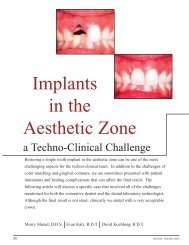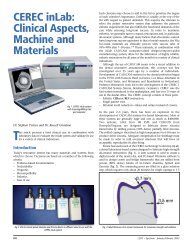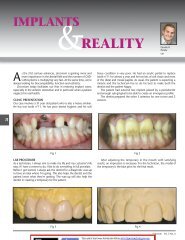Using Contemporary Concepts of Occlusion and ... - Dentropolis
Using Contemporary Concepts of Occlusion and ... - Dentropolis
Using Contemporary Concepts of Occlusion and ... - Dentropolis
Create successful ePaper yourself
Turn your PDF publications into a flip-book with our unique Google optimized e-Paper software.
<strong>Using</strong> <strong>Contemporary</strong><strong>Concepts</strong> <strong>of</strong><strong>Occlusion</strong> <strong>and</strong>Retention forImplant-SupportedComplete DentureRestorationsGeorge Priest, DMD <strong>and</strong> Ernest Caragol, CDTGeorge Priest, DMDErnest Caragol, CDTncorporating dental implants for theedentulous patient significantly improvesdenture base stability, thus increasing thepatient’s ability to transmit greater occlusalforces during chewing, swallowing <strong>and</strong>,particularly, clenching/bruxing to a level fargreater than with conventional dentures.Therefore, the importance <strong>of</strong> occlusion cannot be understated for the long term success<strong>of</strong> dental implants supporting removableimplant supported prostheses. Thetechnician <strong>and</strong> clinician are therefore facedwith the challenge <strong>of</strong> determining the idealposterior denture tooth form <strong>and</strong> occlusalscheme that would best satisfy thefunctional <strong>and</strong> esthetic requirements <strong>of</strong> thepatient, without causing undue stress onthe implants <strong>and</strong> the associated oralstructures.Several authors 1,2,3 have accepted theconcept <strong>of</strong> lingualized (lingual contact)occlusion as the contemporary occlusalscheme <strong>of</strong> choice for implant supportedremovable denture restorations. Some <strong>of</strong>the many advantages <strong>of</strong> lingualizedocclusion as it applies to implant supportedremovable restorations include; occlusalforces that are centered over the ridge crestin centric relation, effective transfer <strong>of</strong>forces more “lingual” to the ridges duringworking side excursions (Fig. 1) <strong>and</strong>minimized occlusal disharmonies createdfrom errors in jaw registrations, dentureprocessing changes <strong>and</strong>/or eventual settling<strong>of</strong> the denture base. Additionally, the“mortar <strong>and</strong> pestle” type <strong>of</strong> occlusionminimizes the occlusal contact area <strong>and</strong>provides more efficient bolus penetration,while minimizing destructive horizontalforces. Furthermore, such an occlusalscheme eliminates the preciseintercuspation <strong>of</strong> anatomic teeth that <strong>of</strong>tencomplicates the setting <strong>and</strong> equilibration <strong>of</strong>denture teeth.Fig. 1To this end, the SR Ortholingual toothmould is specifically designed to satisfy thebiomechanical requirements <strong>of</strong> lingualizedCJDT • Spectrum January/February 2003
Fig. 10Fig. 2Fig. 3Shallow M<strong>and</strong>ibularCusp AnglesFig. 4 Fig. 5occlusion (Fig. 2). The tooth designprimarily consists <strong>of</strong> a dominant maxillarylingual cusp (Fig. 3) <strong>and</strong> an uncomplicatedm<strong>and</strong>ibular central fossa (Fig. 4). Themaxillary lingual cusps can articulateanywhere along the m<strong>and</strong>ibular centralfossa, while the maxillary buccal cusps areintentionally left out <strong>of</strong> contact. This leavesthe maxillary lingual cusps as the onlycentric holding contacts, which helps tostabilize the upper <strong>and</strong> lower dentures <strong>and</strong>minimizes the number <strong>of</strong> tooth contacts.(Fig. 5).The following case presentationhighlights the selection, set-up <strong>and</strong>equilibration <strong>of</strong> the SR Ortholingual posteriordenture tooth mould that easily satisfies thetenants <strong>of</strong> lingual contact occlusion. Inaddition, a uniquely designed implantoverdenture retention system (Kugel-B barimplant system/Georgia Dental Laboratory)is described.Case PresentationAn 81-year-old female who had beenedentulous for 25 years presented forreplacement <strong>of</strong> her missing teeth. As part <strong>of</strong>the treatment plan, four implants (ImplantInnovations, Inc.) were placed six monthsprior to obtaining a preliminary alginateimpression. A custom retentive bar wasfabricated <strong>and</strong> placed using the Kugel Bretentive bar pattern (Fig. 6). Custom trayswere border molded with a hydrophilicmonophase vinyl polysiloxane materialFig. 6(Virtual) <strong>and</strong> washed with the samemonophase material. Customary centric<strong>and</strong> vertical jaw registrations were madeusing denture base wax rims.SR Ortholingual posterior denture teethwere selected based on their specific design,which facilitates the establishment <strong>of</strong> alingualized (lingual contact) occlusalscheme. The clinician <strong>and</strong> laboratorytechnician reviewed the treatment plan <strong>and</strong>the patient's aesthetic requirements in orderto select the appropriate tooth arrangement,alignment <strong>and</strong> shade.After receiving the occlusal registrationfrom the doctor, the master casts weremounted on the Stratos 200 articulatorusing the horizontal guide to orient thelower cast to an average Bonwill position.The six anterior maxillary teeth were setaccording to the markings on the occlusalrim: midline, cusped line, high lip line, <strong>and</strong>incisal edge position. The six anteriorm<strong>and</strong>ibular teeth were positioned tocoordinate with the maxillary anterior.The posteriorm<strong>and</strong>ibular teeth werepositioned using atooth set-up template(2D template) (Fig. 7)which is a component<strong>of</strong> the Stratos 200Fig. 7articulation system.This particulartemplate is simple to use, since it is attachedto the articulator (Fig.s 8 & 9). H<strong>and</strong>-heldtemplates can also be used but aresomewhat more difficult to manage. TheFig. 8Fig. 9Fig. 11template assures that the m<strong>and</strong>ibularposterior teeth are set bilaterallysymmetrical on a predetermined anteroposterior<strong>and</strong> mesiolateral curve. Thisgreatly facilitates the positioning <strong>of</strong> themaxillary posterior teeth <strong>and</strong> thesubsequent balanced occlusion. TheSR Ortholingual tooth mould easily workswith a template, since each cusp tip isdesigned to contact the template (Fig. 10).This allows the teeth to be positioned rathersimply <strong>and</strong> quickly.The case was prepared for a wax try-in,(Fig. 11) <strong>and</strong> returned to the laboratory withphotos <strong>of</strong> the intra-oral tissue <strong>and</strong>instructions for acrylic characterization. Thedentist specified one <strong>of</strong> the following skin<strong>and</strong> hair combinations corresponding to thepatient's appearance: fair skin/light haircolor; olive skin/dark hair color; ebonyskin/dark brown/black hair. Based thisinformation, the technician selected theappropriate characterization scheme <strong>and</strong>tinted the following areas <strong>of</strong> the denturebase: interproximal spaces to simulatevascularity; root eminences, especially thecanine eminence to create a blanched effect;<strong>and</strong> the labial frenum. The stains areinternally colored, methymetharylate-based40 CJDT • Spectrum January/February 2003
Fig. 13Fig. 14Fig. 12co-polymer (Kayon denture tinting kit) <strong>and</strong>will not alter the physical properties <strong>of</strong> thedenture resin, fade or change with time.Processing was completed using theSR Ivocap injection system (Fig. 12) Thissystem is preferred due to its capacity tocompensate for the polymerizationshrinkage that occurs during conventionalacrylic resin processing. A second processingprocedure was required for the addition <strong>of</strong> aheat cured silicone liner in the area <strong>of</strong> theKugel B retention bar (fig. 13). Thisprocedure provided the denture withpredictable retention <strong>and</strong> easy maintenancewhen compared to other conventionalretentive attachment systems. This retentivebar system is patented as the Georgia DentalLaboratory Kugel-B liner Process. To obtainmore information on this process, pleaserefer to the end <strong>of</strong> the article.Typically minimal adjustments wererequired at the denture insertionappointment. The lingual contact occlusalscheme provided a rather simplistic method<strong>of</strong> adjusting the occlusion after processing.The re-establishment <strong>of</strong> lingual cuspcontacts to the central fossa <strong>of</strong> them<strong>and</strong>ibular teeth was easy to visualize <strong>and</strong>quite simple to adjust. Adjustments can bedone chairside or by mounting the denturesusing a new centric record. The processedsilicone provided reliable retention <strong>and</strong> easyinsertion as well. The results were maximumesthetics, minimal adjustment, excellentfunction <strong>and</strong> predictable retention (Fig. 14).ConclusionLingualized (lingual contact) occlusion wasthe occlusal scheme <strong>of</strong> choice for thisimplant supported restoration due to themany advantages previously stated. TheSR Ortholingual tooth mould from IvoclarVivadent has provided a tooth form that isspecifically designed for this concept <strong>and</strong>has greatly facilitated the establishment <strong>of</strong>this desired occlusal scheme withoutsacrificing esthetics or function. A uniqueoverdenture retentive bar system (Kugel Bbar implant system) was also described.References1. Lang BR, Razzoog ME: A practicalapproach to restoring occlusion foredentulous patients: Part 1. Guidingprinciples <strong>of</strong> tooth selection. J ProsthetDent 50:455-458, 19832. Lang BR, Razzoog ME: Lingualizedintegration: tooth molds <strong>and</strong> anocclusal scheme for edentulous implantpatients. Implant Dent (3): 204-211,19923. Garg A, Practical Implant Dentistry,Taylor Publishing Company, 199642 CJDT • Spectrum January/February 2003





